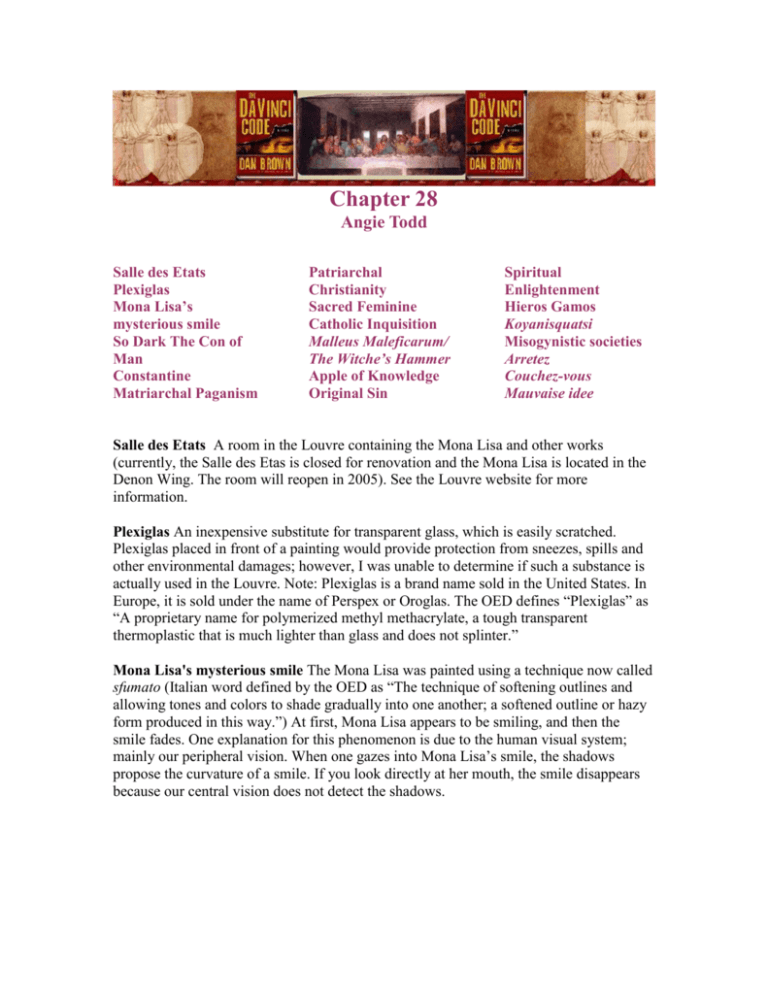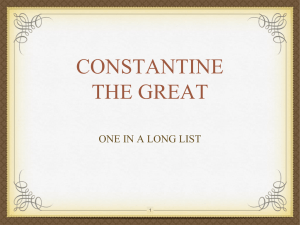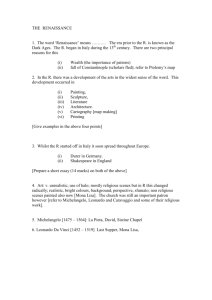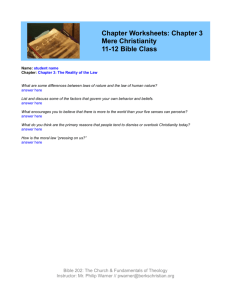
Chapter 28
Angie Todd
Salle des Etats
Plexiglas
Mona Lisa’s
mysterious smile
So Dark The Con of
Man
Constantine
Matriarchal Paganism
Patriarchal
Christianity
Sacred Feminine
Catholic Inquisition
Malleus Maleficarum/
The Witche’s Hammer
Apple of Knowledge
Original Sin
Spiritual
Enlightenment
Hieros Gamos
Koyanisquatsi
Misogynistic societies
Arretez
Couchez-vous
Mauvaise idee
Salle des Etats A room in the Louvre containing the Mona Lisa and other works
(currently, the Salle des Etas is closed for renovation and the Mona Lisa is located in the
Denon Wing. The room will reopen in 2005). See the Louvre website for more
information.
Plexiglas An inexpensive substitute for transparent glass, which is easily scratched.
Plexiglas placed in front of a painting would provide protection from sneezes, spills and
other environmental damages; however, I was unable to determine if such a substance is
actually used in the Louvre. Note: Plexiglas is a brand name sold in the United States. In
Europe, it is sold under the name of Perspex or Oroglas. The OED defines “Plexiglas” as
“A proprietary name for polymerized methyl methacrylate, a tough transparent
thermoplastic that is much lighter than glass and does not splinter.”
Mona Lisa's mysterious smile The Mona Lisa was painted using a technique now called
sfumato (Italian word defined by the OED as “The technique of softening outlines and
allowing tones and colors to shade gradually into one another; a softened outline or hazy
form produced in this way.”) At first, Mona Lisa appears to be smiling, and then the
smile fades. One explanation for this phenomenon is due to the human visual system;
mainly our peripheral vision. When one gazes into Mona Lisa’s smile, the shadows
propose the curvature of a smile. If you look directly at her mouth, the smile disappears
because our central vision does not detect the shadows.
"So Dark The Con Of Man" Rearranged, the letters in this message spell out “Madonna
of the Rocks,” a clue to the resting place of yet another clue. (Defined at the end of the
chapter).
Constantine Bborn Feb. 27 (after AD 280?), died May 22, AD 337. Constantine was
emperor in ancient Western Europe. According to a legend, a cross appeared to him
bearing the words “in hoc signo vinces” or “In this sign, conquer.” From then on,
Constantine initiated the Edict of Milan to end persecution of any form to Christians and
subsequently adopted Christianity himself. Eventually he gained control over the East,
proclaimed himself ‘sole emperor,’ and moved the capital from Rome to Byzantium
(which he renamed Constantinople). With his support, Christianity was popularized and
became a widely-accepted faith. According to many sources, Constantine forced the
world from matriarchal paganism to patriarchal Christianity and condemned the sacred
feminine. (Encyclopedia Britannica Online).
www.sln.org.uk/timeline/ images/constantine.gif
Matriarchal Paganism A pagan (also called a heathen) is a person who does not believe
in ‘God’. These pagans generally worshiped nature and valued idols. Matriarchal
Paganism is a religious belief where worshipers believe that the woman is divine and
views her as the bringer of life. This faith considers Jesus as a mortal man and believes
Mary Magdalene was a goddess. They also believed that the Book of Genesis in the Bible
was written to demonize women and to support man as the creator. See a great
Powerpoint presentation for more information:http://www.probe.org/sacred_feminine.ppt
Patriarchal Christianity Opposed to matriarchal paganism, Patriarchal Christianity is a
belief in spirits and views man as the creator. They believe in the divination of God, in
Jesus, who was a part of God, and that spirits dwell in all things (including places, plants
and animals). Patriarchal Christianity gained popularity around the time of Constantine’s
rule. http://www.probe.org/sacred_feminine.ppt
Jesus on the Cross www.mc.maricopa.edu/.../ images/stavromeno.jpg
Sacred Feminine A viewpoint that respects and worships the woman as well as the
attributes of women. The sacred feminine refers to the beliefs of matriarchal paganism
and that all women are divine due to the fact that they bring new life to the world.
http://www.sacred-feminine.org/
The symbol of the Sacred Feminine is the Pentacle
The Catholic Inquisition The Roman Catholic Church decided to eliminate all
deviances from Christianity because they felt threatened by these people. The sentence
for believing and preaching these variations was life imprisonment for those who
repented their sins, and capital punishment for those who persevered with their beliefs.
Secular authorities burned people at the stake and confiscated all property from these
‘criminals’. The accused had no legal rights and were punished by ‘word of mouth’.
http://es.rice.edu/ES/humsoc/Galileo/Things/inquisition.html
http://www.sundayschoolcourses.com/inq/inqcont.htm#IntroductionMalleus
Maleficarum/The Witch's Hammer A publication of the Catholic Church in 1486
which served as guidelines for the Secular authorities in the Inquisition. This document
was designed to help them identify, prosecute and dispatch witches. Although the
Christians were unsure of the existence of witches, they felt the church was in danger and
published the Malleus Maleficarum to eliminate the threat.
http://www.malleusmaleficarum.org/AppleofKnowledge
Original Sin (See Chapter 7) According to the Catholic Encyclopedia, original sin was
the sin that Adam and Eve committed, or a consequence of this first sin, the hereditary
stain with which we are born on account of our origin or descent from Adam.
Spiritual Enlightenment- The primary goal of many religions is to reach this awakened
state of consciousness.
"A human being is a part of a whole, called by us universe, a part limited in time and
space. He experiences himself, his thoughts and feelings as something separated
from the rest... a kind of optical delusion of his consciousness. This delusion is a
kind of prison for us, restricting us to our personal desires and to affection for a few
persons nearest to us. Our task must be to free ourselves from this prison by
widening our circle of compassion to embrace all living creatures and the whole of
nature in its beauty."
- Albert Einstein (http://www.experiencefestival.com/enlightenment)
Hieros Gamos The Hieros Gamos was a traditional ritual fusing man and woman in the
most sacred and holy way…in sexual union. This fertility ceremony had men and women
dressed as gods while partaking in sexual intercourse. The festival included a ‘marriage’
celebration, an exchange of gifts, a purification rite, wedding feast and intercourse.
www.britannica.com
Koyanisquatsi According to the Hopi Dictionary, Koyaanisqatsi meaning “life out of
balance” is present. The novel contains either an alternative spelling or a misprint.
Misogynistic societies A society that hates or is prejudiced against women. (Oxford
English Dictionary).
Arretez- “Stop!”
Couchez-vous- “Lie Down!”
Mauvaise idee- “Bad Idea!”








